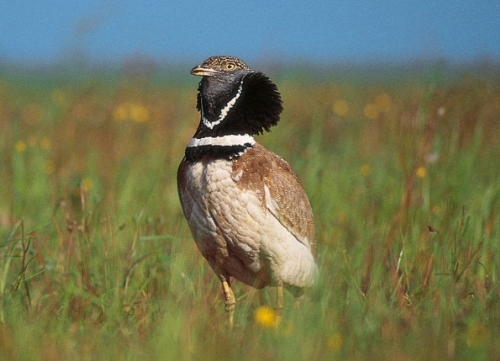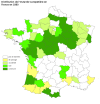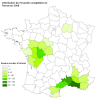Birds of France



Little Bustard
Tetrax
tetrax
Outarde canepetière
Range: Historically the Little Bustard inhabited a vast range from Portugal to the extreme Northwest of China but after large population declines in the late 19th and 20th centuries it became extinct in many countries and today two distinct breeding populations remain, a western one with Portugal, Spain, France, Sardinia and the extreme Southeast of Italy; and an eastern one in South-eastern Russia and Kazakhstan.
In

Changes in
agricultural practices have resulted in the reduction of food
resources and nesting sites which are limiting factors for lowland birds.
The Little Bustard, far from being an exception, has seen its numbers tumble
drastically in the cultivated plains of
About the Little Bustard:
The Little Bustard is
quite a large bird at 44 cm, (that’s about Crow size), rather shy with a
tendency to crouch down and lie flat in ground cover when disturbed. It is
fully migratory in the west of
They have a method of
reproduction that is extremely rare in the bird world and when in April the
birds arrive at the breeding sites the males form small groups where they
begin their extraordinary mating rituals, leaping up and down hammering the
ground with wings extended, neck feathers fluffed out in a large ruff while
at the same time making their distinctive chant, quite a spectacular
display!
The females visit the males display area
to choose a male to breed with, this makes the males even more excited; then
the female makes her choice and coupling takes place – this is all she will
have to do with the male, she then departs, prepares her own “nest” site,
which is a small hollow in the ground, incubates and raises her chicks with
no further assistance or contact with the male.

Above - Male Little Bustard / Below - Little Bustard chick

Reproduction and breeding in captivity - the
migratory Little Bustard building program.
Registered with the national recovery plan and
the national action plan, the building program for the migratory populations
of Little Bustards began under the second
At the end of the
Le Centre d’Etudes Biologiques de Chizé (
Bustard
eggs incubated at POPRC can also come from the natural environment when
broods are saved during field cutting. From hatching to 15 days old the
chicks are placed in heated boxes and receive between 5 and 10 meals per day
as they grow. The diet has been gradually developed since 1996 by
The situation with the breeding and protection program is far from settled or guaranteed with funding issues and a continual struggle to reconcile the demands to use all the land for economic purposes, (agriculture), against providing protection for endangered native species or indeed any native species that continue to decline resulting from human activity.
RED LISTED AS NEAR THREATENED.
This species is listed as Near Threatened because it
is experiencing a moderately rapid overall population decline,
driven by rapid declines in the west of its range owing mainly to
degradation and loss of habitat as well as low-level hunting pressure.
Recent increases in the east of its range are not quantified, and require
further study. Such data may have implications for the overall population
trend and listing of the species.
Mentioned above was the term "singing
males".Counting singing males in spring - early summer is one method of
population measurement, the other is for organised teams of people to go to
known pre-migration assembly areas in September / October and count all the
Bustards that can be seen. Towards the end of the video in the link the male Bustard throws
its head back and makes almost a long click or grunt sound - this is the
sound to listen out for in the field to locate males when not visible.
Little Bustard video HERE




